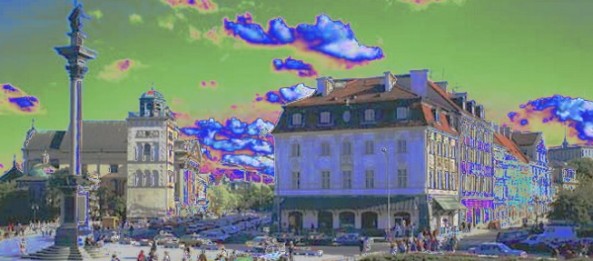
On 22 February 2010 the Polish Post introduced a new stamp „Year of Fryderyk Chopin”. The stamp won the plebiscite on the „most beautiful stamp of Warsaw’s motives”, organised by the Board of the Polish Union of Philatelists. Source: http://blog.radekjaworski.com/?p=256
Warsaw is a city in Poland … However, we can find the fragments of Warsaw all over the world – copies of statues, sculptures and even parts of Warsaw’s buildings scattered around the world. People living in countries where they can see the pieces of Warsaw every day, do not even know about their Polish origin.
FREDERIC CHOPIN MONUMENT
Frédéric Chopin (Polish: Fryderyk Chopin, also phonetically Szopen, 1 March 1810 – 17 October 1849) was a Polish composer and virtuoso pianist of French-Polish parentage. He is considered one of the great masters of Romantic music. Chopin was born in Żelazowa Wola, a village in the Duchy of Warsaw, but he grew up in Warsaw and completed his music education there; he composed many mature works in Warsaw before leaving Poland in 1830 at age 20, shortly before the November 1830 Uprising. Following the Russian suppression of the Uprising, he settled in Paris as part of Poland’s Great Emigration. During the remaining 19 years of his life, Chopin gave only some 30 public performances, preferring the more intimate atmosphere of the salon; he supported himself by sales of his compositions and as a piano teacher. After some romantic dalliances with Polish women, including an abortive engagement, from 1837 to 1847 he carried on a relationship with the French writer Amantine Dupin (pen name “George Sand”). For most of his life, Chopin suffered from poor health; he died in Paris in 1849 at age 39.
The Chopin Statue stands in the upper part of Warsaw’s Royal Baths Park (Łazienki Park), adjacent to Aleje Ujazdowskie (Ujazdów Avenue). It was designed in 1907 by Polish artist Wacław Szymanowski for its planned erection on the centenary of Chopin’s birth in 1910, but its execution was delayed by controversy about the design, then by the outbreak of World War I. The statue was finally cast and erected in 1926.
During World War II, the statue was destroyed by the occupying Germans on May 31, 1940. According to local legend, the next day a handwritten sign was found at the site which read: “I don’t know who destroyed me, but I know why: so that I won’t play the funeral march for your leader.” The original mould for the statue, which had survived the war, made it possible to cast a replica, which was placed at the original site in 1958. At the statue’s base, since 1959, on summer Sunday afternoons are performed free piano recitals of Chopin’s compositions. The stylized willow over Chopin’s seated figure echoes a pianist’s hand and fingers.
1. Warsaw, Poland– one of Warsaw’s landmarks visited on every Sunday during the Summer for free of charge open-air Chopin music piano recitals, very popular among tourists and locals. Szymanowski’s statue was the world’s tallest Chopin monument until the unveiling, on March 3, 2007, of the slightly taller, modernistic bronze in Shanghai, China.
2. Poznań, Poland – before WW2 the wooden copy of Chopin’s statute in 1:2 scale was given to Wielkopolskie Museum in Poznań (today the building houses the National Museum in Poznań). The statue was destroyed by the Nazis during the war
3. Paris, France – Barbedienne studio, 1926 – Szymanowski worked on the statue in Paris, when it was ready it was transported to Warsaw and placed in Łazienki park. The ceremony was held on November 14, 1926
4. Hamamatsu, Japan – Act City Hamamatsu – a 1:1-scale replica of Szymanowski’s statue is set on the roof garden of one of the buildings composing “Act City Hamamatsu”. “Act City Hamamatsu” is a big complex of a few buildings in which are concert halls, convention halls, museums, exhibition halls, offices, hotels and shops. Its construction was sponsored by Hamamatsu city and private enterprises, and completed in 1994. It is located just a few minutes from JR Hamamatsu station. The roof garden where we see the copy of Chopin monument on the “Chopin’s hill” is named “Square of Relaxation”. The copy of the monument was set in commemoration of the 1990 agreement of musical and cultural exchanges between Hamamatsu city and Warsaw city. The bronze statue was made by a Japanese company. Hamamatsu city tries to make the monument as a symbol to present itself as a city of culture and music.
5. Chicago, Illinois, USA – project to erect Warsaw Chopin monument replica in Chopin Park in Chicago. The year 2010 marked the 200th anniversary of the birth of Frederic Chopin. In honor of Chopin’s contribution to music “We The People of Chicago” want to bring Chopin to Our City and to erect a copy of the famous Art Nouveau Chopin Monument in Warsaw’s Royal Baths Park here downtown in Chicago. It will be a fitting tribute to commemorate the 200th anniversary of one of the most influential composers ever. The intent to locate Chopin’s monument in one of Chicago’s tourist hotspots – Chicago Grant Park, section between 11 St. & South Michigan Ave. and Museum Campus- Metra Station , will expose it to the greatest number of people of Chicago and tourists alike. Temporary name for the project “Chopin Garden”. It will be another architectural jewel in the crown of Chicago architectural marvels. More about the project: http://www.chopinmonumentinchicago.com










